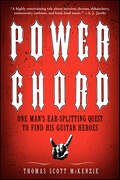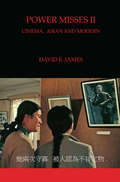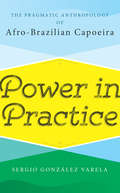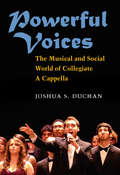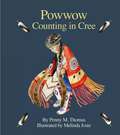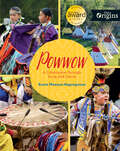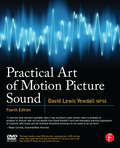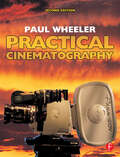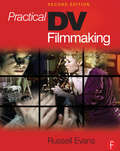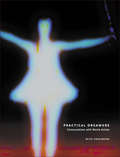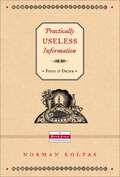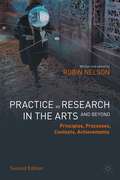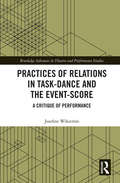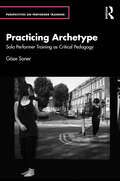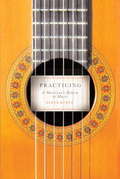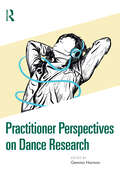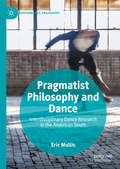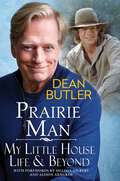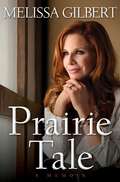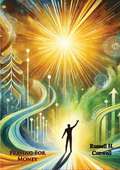- Table View
- List View
Power Chord: One Man's Ear-Splitting Quest to Find His Guitar Heroes
by Thomas Scott McKenziePower Chord is the story of one man’s epic pilgrimage to gain rock enlightenment from the gods and guitar heroes of the Golden Age of heavy metal. Author Scott McKenzie set off to make contact with the legendary metal superstars he worshipped in his rural Kentucky youth—men like George Lynch of Dokken, Glen Tipton of Judas Priest, and Ace Frehley of KISS—hoping to gain wisdom and a better understanding of the electric guitar mystique. The result is a veritable treasure trove of enthralling behind-the-scenes stories and “where are they now” revelations that will delight anyone who has ever felt a Mötley Crüe, Guns ’N’ Roses, or Black Sabbath song reach out from the speakers and grab them by the ears.
Power Misses II: Cinema, Asian and Modern
by David E. JamesLike David James' earlier collection of essays, Power Misses: Essays Across (Un)Popular Culture (1996), the present volume, Power Misses II: Cinema, Asian and Modern is concerned with popular cultural activity that propose alternatives and opposition to capitalist media. Now with a wider frame of reference, it moves globally from west to east, beginning with films made during the Korean Democracy Movement, and then turning to socialist realism in China and Taiwan, and to Asian American film and poetry in Los Angeles. Several other avant-garde film movements in L.A. created communities resistant to the culture industries centered there, as did elements in the classic New York avant-garde, here instanced in the work of Ken Jacobs and Andy Warhol. The final chapter concerns little-known films about communal agriculture in the Nottinghamshire village of Laxton, the only one where the medieval open-field system never suffered enclosure. This survival of the commons anticipated resistance to the extreme and catastrophic forms of privatization, monetization, and theft of the public commonweal in the advanced form of capitalism we know as neoliberalism.
Power in Practice: The Pragmatic Anthropology of Afro-Brazilian Capoeira
by Sergio González VarelaConsidering the concept of power in capoeira, an Afro-Brazilian ritual art form, Varela describes ethnographically the importance that capoeira leaders (mestres) have in the social configuration of a style called Angola in Bahia, Brazil. He analyzes how individual power is essential for an understanding of the modern history of capoeira, and for the themes of embodiment, play, cosmology, and ritual action. The book also emphasizes the great significance that creativity and aesthetic expression have for capoeira's practice and performance.
Powerful Voices: The Musical and Social World of Collegiate a Cappella
by Joshua S. DuchanCollegiate a cappella, part of a long tradition of unaccompanied singing, is known to date back on American college campuses to at least the colonial era. Considered in the context of college glee clubs, barbershop quartets, early-twentieth-century vocal pop groups, doo-wop groups, and late-twentieth-century a cappella manifestations in pop music, collegiate a cappella is an extension of a very old tradition of close harmony singing---one that includes but also goes beyond the founding of the Yale Whiffenpoofs. Yet despite this important history, collegiate a cappella has until now never been the subject of scholarly examination. InPowerful Voices: The Musical and Social World of Collegiate A Cappella, Joshua S. Duchan offers the first thorough accounting of the music's history and reveals how the critical issues of sociability, gender, performance, and technology affect its music and experience. Just as importantly, Duchan provides a vital contribution to music scholarship more broadly, in several important ways: by expanding the small body of literature on choruses and amateur music; by addressing musical and social processes in a field where the vast majority of scholarship focuses on individuals and their products; and by highlighting a musical context long neglected by musicologists---the college campus. Ultimately,Powerful Voicesis a window on a world of amateur music that has begun to expand its reach internationally, carrying this uniquely American musical form to new global audiences, while playing an important role in the social, cultural, and musical education of countless singers over the last century.
Powerhouse: The Untold Story of Hollywood's Creative Artists Agency
by James Andrew Miller<P>An astonishing--and astonishingly entertaining--history of Hollywood's transformation over the past five decades as seen through the agency at the heart of it all, from the #1 bestselling co-author of Live from New York and Those Guys Have All the Fun. <P>The movies you watch, the TV shows you adore, the concerts and sporting events you attend--behind the curtain of nearly all of these is an immensely powerful and secretive corporation known as Creative Artists Agency. Started in 1975, when five bright and brash employees of a creaky William Morris office left to open their own, strikingly innovative talent agency, CAA would come to revolutionize the entertainment industry, and over the next several decades its tentacles would spread aggressively throughout the worlds of movies, television, music, advertising, and investment banking. <P>Powerhouse is the fascinating, no-holds-barred saga of that ascent. Drawing on unprecedented and exclusive access to the men and women who built and battled with CAA, as well as financial information never before made public, author James Andrew Miller spins a tale of boundless ambition, ruthless egomania, ceaseless empire building, greed, and personal betrayal. It is also a story of prophetic brilliance, magnificent artistry, singular genius, entrepreneurial courage, strategic daring, foxhole brotherhood, and how one firm utterly transformed the entertainment business. <P>Here are the real Star Wars--complete with a Death Star--told through the voices of those who were there. Packed with scores of stars from movies, television, music, and sports, as well as a tremendously compelling cast of agents, studio executives, network chiefs, league commissioners, private equity partners, tech CEOs, and media tycoons, Powerhouse is itself a Hollywood blockbuster of the most spectacular sort. <P><b>A New York Times Bestseller</b>
Powwow Counting in Cree
by Penny M. ThomasThis unique counting book introduces Cree numbers, from one to ten. Featuring powwow imagery that reflects the rich culture and tradition of the Cree people, rhyme, rhythm, and glowing illustration combine to make language learning a joyful experience for young readers. A pronunciation guide is included in the back of the book. Winner of McNally Robinson Book for Young People AwardSelected for The Canadian Children&’s Book Centre&’s Best Books for Kids & TeensApproved resource for Manitoba classrooms
Powwow Counting in Cree
by Penny M. ThomasThis unique counting book introduces Cree numbers, from one to ten. Featuring powwow imagery that reflects the rich culture and tradition of the Cree people, rhyme, rhythm, and glowing illustration combine to make language learning a joyful experience for young readers. A pronunciation guide is included in the back of the book. Winner of McNally Robinson Book for Young People AwardSelected for The Canadian Children&’s Book Centre&’s Best Books for Kids & TeensApproved resource for Manitoba classrooms
Powwow Counting in Cree
by Penny M. ThomasThis unique counting book introduces Cree numbers, from one to ten. Featuring powwow imagery that reflects the rich culture and tradition of the Cree people, rhyme, rhythm, and glowing illustration combine to make language learning a joyful experience for young readers. A pronunciation guide is included in the back of the book. Winner of McNally Robinson Book for Young People AwardSelected for The Canadian Children’s Book Centre’s Best Books for Kids & TeensApproved resource for Manitoba classrooms
Powwow: A Celebration through Song and Dance (Orca Origins #7)
by Karen Pheasant-Neganigwane★ “Clearly organized and educational—an incredibly useful tool for both school and public libraries.” —School Library Journal, starred review Powwow is a celebration of Indigenous song and dance. Journey through the history of powwow culture in North America, from its origins to the thriving powwow culture of today. As a lifelong competitive powwow dancer, Karen Pheasant-Neganigwane is a guide to the protocols, regalia, songs, dances and even food you can find at powwows from coast to coast, as well as the important role they play in Indigenous culture and reconciliation. The epub edition of this title is fully accessible.
Practical Art of Motion Picture Sound: Professional Techniques Of Motion Picture And Television Audio
by David Lewis YewdallPractical Art of Motion Picture Sound, 4th edition relies on the professional experience of the author and other top sound craftspeople to provide a comprehensive explanation of film sound, including mixing, dubbing, workflow, budgeting, and digital audio techniques.
Practical Cinematography
by Paul WheelerFilmmaking is an art, but, like so many art forms, there are basic underlying tools and techniques and a body theoretical knowledge that must be understood and mastered before artistic expression can flourish. This book is an invaluable resource for all aspiring DoPs. Practical Cinematography can be dipped into for quick reference - perhaps to answer a specific question or deal with practical problems relating to a shoot - or read from cover to cover. It discusses the principles of cinematography and the expertise which is unique to the Director of Photography (DoP). It deals with all the basic theory such as color temperature and sensitometry, and all the practical things a DoP needs to know, from the make-up of the crew to how to prepare an equipment list.
Practical DV Filmmaking
by Russell EvansWritten for the beginner, Practical DV Filmmaking guides you thorough the process of making a film with low-cost digital equipment: from development through to production, post-production and distribution. While the technical tools you need are fully explained, the book concentrates on filmmaking principles throughout, illustrating how these tools can be used to achieve stylistic approaches for innovative filmmaking.The book assumes no background knowledge in either technology or filmmaking and is divided into four key areas:*DEVELOPMENT: turn your idea into a workable script, storyboard and schedule.*PRODUCTION: develop skills to shoot original short films and turn a zero-to-low budget to your advantage.*POST-PRODUCTION: learn basic editing techniques to enhance your original idea using iMovie, Premiere and other popular tools.*DISTRIBUTION: set up a website and use the internet to promote your film. Includes numerous links to useful websites. Plus, top tips for how to enter a film festival and a new chapter on developing a career.Projects enable you to master each step of the process taking you through different aspects of filmmaking today. Gradually you will find out where your strengths lie and how to make the most of them. The book also encourages stylistic development by intruding theoretical approaches to filmmaking. A glossary of terms plus an appendix of resources make this guide a one-stop essential handbook to DV filmmaking practice for beginners and student filmmakers.
Practical Dreamers: Conversations with Movie Artists
by Mike Hoolboom'The streets are full of admirable craftsmen, but so few practical dreamers.' Man Ray What if there were movies made th same way as suits, custom fitted, each one tailored for one person? Not broadcast, but narrowcast? Not theatres around the world showing the same globalized pictures, but instead a local circumstance, a movie so particular, so peculiar, it could cure night blindness or vertigo? Welcome to the world of fringe movies, where artists have been busy putting queer shoulders to the wheels, or bending light to talk about First Nations rights (and making it funny at the same time), or demonstrating how a personality can be taken apart and put together again, all in the course of a ten-minute movie which might take years to make. Practical Dreamers takes us to this other side of the media plantation. In it, twenty-seven Canadian artists dish about how they get it done and why it matters. The conversations are personal, up close and jargon free, smart without smarting. The stellar cast includes smartbomb Steve Reinke; visionary Peter Mettler; Middle East specialist Jayce Salloum; queer Asian avatars Richard Fung, Midi Onodera, Ho Tam, and Wayne Yung; footage recyclers Aleesa Cohene and Jubal Brown; overhead projector king Daniel Barrow; First Nations vets Kent Monkman and Shelley Niro; international art presence Paulette Phillips; and documentarian Donigan Cumming. These in-depth talks come lavishly illustrated in an oversized volume.
Practically Useless Information on Food and Drink
by Norman KolpasThe ultimate gift book for the epicure who has everything. It features such facts as the names and sizes of champagne bottles, step-by-step instructions on how to slice a banana without peeling it (or even cutting the peel), the menu served the night the Titanic sank, ten edible figures of speech, intriguing quotes on eating and drinking from Kenneth Grahame, William Shakespeare, and Charles Dickens.Clever, engaging, and easy to browse for fun. For people seeking a resource on esoteric information, it is indexed for easy access to specific topics.
Practically Useless Information on Weddings
by Norman KolpasThe ultimate gift book for the bride, her mother, bridesmaids, friends, and the occasional groom. Fascinating facts include the world's longest wedding ceremony, shortest ceremony, and most-watched ceremony (on television). Also included is vital information on diamond engagement rings, gift guidelines for each anniversary, the significance of rice, the meaning of flowers used in bouquets, and the story behind traditions and sayings like "something old, something new." The book will be equally popular as a gift and curiosity for the nearly wed or as a resource for those hard-to-find facts that provide the background on much of the traditional wedding lore. A complete index provides access by topic.
Practice as Research in the Arts (and Beyond): Principles, Processes, Contexts, Achievements
by Robin NelsonThis project addresses the contexts of Practice as Research and how to undertake it. This second iteration updates thinking and practices but sustains a direct and clear approach on how to become a practitioner-researcher. New features include an extension of range “beyond” the arts and a case for intra-disciplinarity in Practice Research as an influence in the formation of the “future university”. A comparison is made between Artistic Research and Practice Research recognizing that research through practices with being-doing-knowing is central to both. Acknowledging the current crisis in legitimation, a broad view is taken of how things might be known by an onto-epistemology for the twenty-first century foregrounding the bodymind but sustaining rationality and community by way of Other/other dialogic exchange. Perspectives from around the world in Part II offset the more Eurocentric emphasis in Part I.
Practices of Relations in Task-Dance and the Event-Score: A Critique of Performance (Routledge Advances in Theatre & Performance Studies)
by Josefine WikströmIn this study, Josefine Wikström challenges a concept of performance that makes no difference between art and non-art and argues for a new concept. This book confronts and criticises the way in which the dominating concept of performance has been used in Art Theory, Performance- and Dance Studies. Through an analysis of 1960s performance practices, Wikstrom focuses specifically on task-dance and event-score practices as well as through examination of the key philosophical concepts that are inseparable from such a concept of art, and are necessary for the reconstruction of a critical concept of performance such as: ‘practice’, experience’, ‘object’, ‘abstraction’ and ‘structure. This book will be of great interest to scholars, students and practitioner across dance, performance art, aesthetics and art theory.
Practicing Archetype: Solo Performer Training as Critical Pedagogy (Perspectives on Performer Training)
by Göze SanerPracticing Archetype addresses performer training, specifically the self-pedagogy of actors who train solo, on their own, as an independent learning process, an opportunity for embodied research, and a form of critical pedagogy.Joining the current critical and inclusive turn in performer training, the author reconfigures the psychophysical ‘work on self’ trope as ‘encounters with the self' and turns to the genre of solo performance, including examples of solo activism from recent years, for a deeper understanding into how the self always already implicates and relates to others. The space that opens in the dialogue between performer training and solo performance is negotiated around three key themes: presence, identity, and action. Using a methodology grounded in archetypal psychology alongside liberation psychology and decolonial feminist thought, and engaging the mythological figures Echo, Odysseus, and Sisyphus, the author reviews specific archetypal images that appear in key performer training texts and revisits well-known practices through the insights drawn from solo performance. Offering audio-guided exercises traditionally used in performer training as embodied forms of inquiry into the relationships between the individual and the various collectives surrounding her, the volume proposes that solo performer training can be mobilised for multiple interrelated objectives – creative, artistic, or professional development; critical, reflective, liberatory pedagogy; and spiritual, archetypal, imaginative encounters.The book speaks to all who are engaged in performer training – students and teachers, soloists and ensembles – as well as those with an interest in embodied forms of critical pedagogy or decolonial approaches to archetype.
Practicing: A Musician's Return to Music
by Glenn KurtzThe remarkable odyssey of a classical guitar prodigy who abandons his beloved instrument in defeat at the age of twenty-five, but comes back to it years later with a new kind of passion. With insight and humor, Glenn Kurtz takes us from his first lessons at a small Long Island guitar school at the age of eight, to a national television appearance backing jazz legend Dizzy Gillespie, to his acceptance at the elite New England Conservatory of Music. He makes bittersweet and vivid a young man's struggle to forge an artist's life--and to become the next Segovia. And we see him after graduation, pursuing a solo career in Vienna but realizing that he has neither the ego nor the talent required to succeed at the upper reaches of the world of classical guitar--and giving up the instrument, and his dream, entirely. Or so he thought. For, returning to the guitar, Kurtz weaves into the larger narrative the rich experience of a single practice session, demonstrating how practicing--the rigor, attention, and commitment it requires--becomes its own reward, an almost spiritual experience that redefines the meaning of "success. " Along the way, he traces the evolution of the guitar and reminds us why it has retained its singular popularity through the ages. Complete with a guide to selected musical recordings and methods,Practicingtakes us on a revelatory, inspiring journey: a love affair with music.
Practitioner Perspectives on Dance Research
by Gemma HarmanPractitioner Perspectives on Dance Research is a collection of accounts from scholars, educators, practitioners and makers that present an overview of key themes, arguments, and practices central to their individual research.Built upon conversations recorded as ResDance™ podcast episodes, this edited collection presents both theoretical discussions and first-hand insights into various research practices, engaging with both established and emergent ideas central to dance research. Whilst challenging current thinking, contributors from around the globe additionally offer reflections on ethics and practices of care, pedagogy and education, and the shifting perspectives on methodologies. By providing an accessible exploration of frequently employed approaches, this book illuminates the choices made and considerations taken in dance research practice.This interdisciplinary discourse presents a rich palette of perspectives, approaches and ideas and is ideal for students, researchers, academics and practitioners alike with an interest in the current state of dance, both in research and in practice.
Pragmatist Philosophy and Dance: Interdisciplinary Dance Research in the American South (Performance Philosophy)
by Eric MullisThis book investigates how Pragmatist philosophy as a philosophical method contributes to the understanding and practice of interdisciplinary dance research. It uses the author's own practice-based research project, Later Rain, to illustrate this. Later Rain is a post-dramatic dance theater work that engages primarily with issues in the philosophy of religion and socio-political philosophy. It focuses on ecstatic states that arise in Appalachian charismatic Pentecostal church services, states characterized by dancing, paroxysms, shouting, and speaking in tongues (glossolalia). Research for this work is interdisciplinary as it draws on studio practice, ethnographic field work, cultural history, Pentecostal history and theology, folk aesthetics, anthropological understandings of ecstatic religious rituals, and dance history regarding acclaimed works that have sought to present aspects of religious ecstasy on stage; Doris Humphrey's The Shakers (1931), Mark Godden’s Angels in the Architecture (2012), Martha Clarke’s Angel Reapers (2015) and Ralph Lemon’s Geography trilogy (2005). The project thereby demonstrates a process model of dance philosophy, showing how philosophy and dance artistry intertwine in a specific creative process.
Prairie Man: My Little House Life & Beyond
by Dean ButlerUSA TODAY BestsellerPUBLISHERS WEEKLY BestsellerAn illuminating, insider&’s journey through the world of Little House on the Prairie and beyond, from Dean Butler, who starred as Almanzo Wilder, the man Laura &“Half Pint&” Ingalls married—on the iconic show still beloved by millions of fans as it reaches its 50th anniversary.With a foreword from Melissa Gilbert (Laura) and Alison Arngrim (Nellie)! Cast just before his twenty-third birthday, Dean Butler joined Little House on the Prairie halfway through its run, gaining instant celebrity and fans&’ enduring affection. Ironically, when the late, great Michael Landon remarked that Little House would outlive everyone involved in making it, Butler deemed it unlikely. Yet for four decades and counting, Butler has been defined in the public eye as Almanzo Wilder—a role he views as the great gift of his life. Butler had been cast as a romantic lead before, notably in the made-for-TV movie of Judy Blume&’s Forever, opposite Stephanie Zimbalist. But Little House was, and remains, one of the most treasured shows in television history. As the eventual husband of Laura &“Half-pint&” Ingalls—and the man who would share actress Melissa Gilbert&’s first real-life romantic kiss—Butler landed as a central figure for the show&’s devoted fans. Now, with wit and candor, Butler recounts his passage through the Prairie, sharing stories and anecdotes of the remarkable cast who were his on-screen family. But that was merely the beginning of a diverse career that includes Broadway runs and roles on two other classic shows—Moondoggie in The New Gidget and Buffy&’s ne&’er-do-well father, Hank, in Buffy the Vampire Slayer. Coming of age during a golden era of entertainment, Butler has evolved along with it, and today enjoys success and fulfillment as a director and producer—notably of NBC Golf&’s Feherty—while remaining deeply loyal to Little House. The warmth, heart, and decency that fans of Laura and Almanzo fell in love with on Little House echo through this uplifting memoir, a story, in Butler&’s words, about &“good luck, good television, and the very good—if gloriously imperfect—people who made it so.&”
Prairie Tale: A Memoir
by Melissa GilbertA fascinating, heartbreaking, and ultimately uplifting tale of self-discovery from the beloved actress who earned a permanent place in the hearts of millions when she was just a child. To fans of the hugely successful television series Little House on the Prairie, Melissa Gilbert grew up in a fantasy world with a larger-than-life father, friends and family she could count on, and plenty of animals to play with. Children across the country dreamed of the Ingalls' idyllic life--and so did Melissa. She was a natural on camera, but behind the scenes, life was more complicated. Adopted as a baby into a legendary show business family, Melissa wrestled with questions about her identity and struggled to maintain an image of perfection her mother created and enforced. Only after years of substance abuse, dysfunctional relationships, and made-for-television movies did she begin to figure out who she really was. With candor and humor, the cherished actress traces her complicated journey from buck-toothed Laura "Half-pint" Ingalls to Hollywood starlet, wife, and mother. She partied with the Brat Pack, dated heartthrobs like Rob Lowe and bad boys like Billy Idol, and began a self-destructive pattern of addiction and co-dependence. Left in debt after her first marriage, and struggling to create some sense of stability, she eventually realized that her career on television had earned her popularity, admiration, and love from everyone but herself. Through hard work, tenacity, sobriety, and the blessings of a solid marriage, Melissa has accepted her many different identities and learned to laugh, cry, and forgive in new ways. Women everywhere may have idolized her charming life on Little House on the Prairie, but Melissa's own unexpectedly honest, imperfect, and down-to-earth story is an inspiration.
Prairie Tale: A Memoir
by Melissa GilbertA fascinating, heartbreaking, and ultimately uplifting tale of self-discovery from the beloved actress who earned a permanent place in the hears of millions for her role in Little House on the Prarie when she was just a child.To fans of the hugely successful television series Little House on the Prairie, Melissa Gilbert grew up in a fantasy world with a larger-than-life father, friends and family she could count on, and plenty of animals to play with. Children across the country dreamed of the Ingalls’ idyllic life—and so did Melissa. With candor and humor, the cherished actress traces her complicated journey from buck-toothed Laura "Halfpint" Ingalls to Hollywood starlet, wife, and mother. She partied with the Brat Pack, dated heartthrobs like Rob Lowe and bad boys like Billy Idol, and began a self-destructive pattern of addiction and codependence. She eventually realized that her career on television had earned her popularity, admiration, and love from everyone but herself. Through hard work, tenacity, sobriety, and the blessings of a solid marriage, Melissa has accepted her many different identities and learned to laugh, cry, and forgive in new ways. Women everywhere may have idolized her charming life on Little House on the Prairie, but Melissa’s own unexpectedly honest, imperfect, and down-to-earth story is an inspiration.
Praying For Money
by Russell H. ConwellIn "Praying for Money," Russell H. Conwell, the esteemed Baptist minister, lawyer, and founder of Temple University, explores the transformative power of prayer in achieving financial prosperity. This insightful book delves into the spiritual principles and ethical considerations of seeking wealth through prayer, offering readers a balanced perspective on integrating faith with financial success.Conwell argues that praying for money is not inherently materialistic when approached with the right intentions. Instead, it can be a powerful tool for aligning one's financial goals with a higher purpose, fostering both personal growth and the ability to contribute positively to the world.Key themes include:The Power of Positive Prayer: Conwell explains how sincere, focused prayer can align one’s intentions with divine will, opening doors to opportunities and financial blessings. He offers practical tips on cultivating a prayerful mindset and approaching financial goals with faith and confidence.Aligning Wealth with Purpose: Emphasizing the importance of ethical wealth creation, Conwell encourages readers to seek financial success not for selfish reasons but to fulfill their potential and help others. He argues that wealth gained through integrity and hard work is more fulfilling and sustainable.Overcoming Limiting Beliefs: The book addresses common misconceptions about money and spirituality, urging readers to overcome mental barriers and embrace the idea that financial success and spiritual growth can coexist harmoniously.Whether you are a person of faith looking to enhance your financial situation, a seeker of spiritual growth, or simply interested in the intersection of wealth and spirituality, "Praying for Money" provides practical wisdom and inspiration. Conwell’s timeless teachings encourage readers to view financial success as a means to achieve greater good and fulfill their divine purpose.
